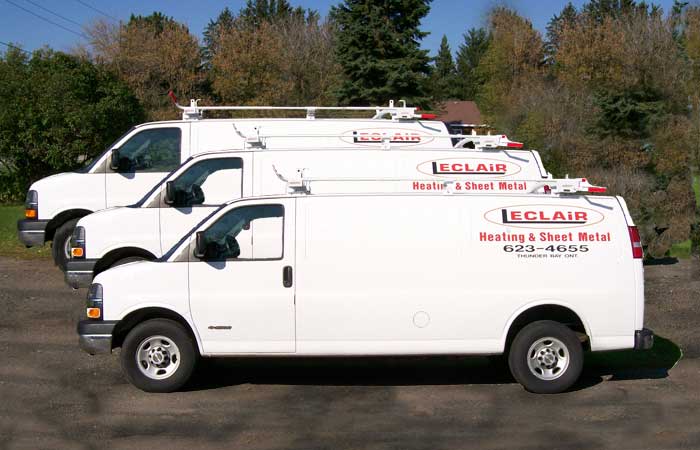



Authorized TRANE Dealer

Copyright ©
Leclair Heating & Sheet Metal.
All rights reserved.
2613 McGregor Pl. Thunder Bay, Ontario P7E 5G9
Phone: (807) 623-4655
Leclair Heating & Sheet Metal.
All rights reserved.
2613 McGregor Pl. Thunder Bay, Ontario P7E 5G9
Phone: (807) 623-4655
Heating & Cooling Glossary
Understanding the Terms
AFUE / Air Cleaner / Air Conditioner / Air Filtration System / Air Handler / BTU / BTUh / Burner / Burner Orifice / Carbon Monoxide / CFM / Compressor / Condenser / Damper / dB / Degree-day / Ductwork / ECM / EER / ERV / Evaporator Coil / Freon® / Heat Exchanger / Heat Pump / HVAC / HVACR / IAQ / Indoor Coil / Indoor-Outdoor system / MERV / Outdoor Coil / Puron® / Refrigerant / Refrigerant Lines / Sealed Combustion Burner / SEER / Split system / Ton /
- AFUE: Annual Fuel Utilization Efficiency. The AFUE number represents how efficiently the appliance is using electricity, oil or gas over the course of a year. The term AFUE is useful to home owners in identifying how much annual heating costs will improve by replacing an existing unit with a higher efficiency unit.
- Air cleaner (also Air Filtration System): Removes airborne dust and allergens from your home.
- Air Conditioner Any device that can change the temperature, humidity or general quality of the air. More specifically, an air conditioner makes your home cooler, by drawing heat energy out of the house and transferring that heat to the outdoors.
- Air Filtration System (also Air Cleaner): Removes airborne allergens and dust from your home.
- Air Handler: The indoor portion of a central air conditioning or heat pump system that forces cooled or heated air through the ductwork in your home. Inside the air handler is a fan and an evaporator coil. Most often the furnace is the air handler for the central air conditioner.
- BTU: British Thermal Unit. The BTU number indicates the amount of heat required to raise the temperature of one pound of water by 1 degree Fahrenheit. This means the higher the BTU rating, the higher the heating or cooling capacity of a product.
- BTUh: British Thermal Units per hour.
- Burner: A device that uses fuel to support combustion.
- Burner Orifice: The opening through which gas flows to the air/gas mixing chamber of the burner.
- Sealed Combustion Burner: A burner that obtains all air for combustion from outside the heated space.
- Carbon Monoxide (CO): An odourless, colourless, tasteless, poisonous and flammable gas that is produced when carbon burns with insufficient air.
- CFM: Cubic Feet per Minute. This measurement indicates how many cubic feet of air pass by a stationary point in one minute. The higher the number, the more air is being forced through the ductwork by the system.
- Compressor: The compressor is located in the outdoor air conditioner (condenser) or heat pump. It compresses and pumps refrigerant throughout the system.
- Condenser: A device or unit used to condense vapour to liquid. The outdoor portion of an air conditioning or heat pump system that serves as a heat transfer point for dispelling heat to the outside air, as in an air conditioner or heat pump in the summer, or for collecting heat from outside air, as in a heat pump in the winter.
- Damper: A movable plate located in the ductwork that regulates airflow. Dampers are used to direct air to the areas that need it most.
- dB: Abbreviation for decibel. Measures sound intensity.
- Degree-day: A degree-day is a computation that gauges the amount of heating or cooling needed for a building. A degree-day is equal to 18°C (65°F) minus the mean outdoor temperature. Thunder Bay tradionally has 5717 Degree Days of heating, and over 70 of cooling.
- Ductwork: Pipes made of sheet metal that carry air from the appliance to the air vents throughout the home.
- ECM: Electronically Commutated Motor. A motor that runs on direct current, saving on electricity.
- EER: Energy Efficiency Ratio is the efficiency rating for the equipment at a particular pair of external and internal temperatures.
- ERV: Energy recovery ventilator (also FreshEffects™) Energy efficient system to exchange stale indoor air for an equal amount of fresher outdoor air.
- Evaporator Coil: (A-Coil) A heat exchanger consisting of two diagonal coils that are joined together in a manner that looks like the letter "A". The part of an air conditioner or heat pump system located inside the house in the air handler. This is where the refrigerant evaporates as it absorbs heat from the air that passes over the coil.
- Freon®: R-22 was used as a refrigerant in air conditioning applications. R-22 is a Hydrochlorofluorocarbon (HCFC) which is an ozone depleting substance and has been replaced by a number of non-CFC refrigerants.
- Heat Exchanger: The part located in the furnace that transfers heat to the surrounding air. The air is then forced throughout the home.
- Heat Pump: Heat Pump is a term for a type of air conditioning in which the refrigeration cycle is able to be reversed producing heat instead of cold in the indoor environment. The indoor evaporator coil switches roles and becomes the condenser coil, producing heat. The outdoor condenser unit also switches roles to service as the evaporator and produces cold air.
- HRV: Heat Recovery Ventilator. A ventilation system that employs a counter flow heat exchanger between the inbound and outbound airflow. An HRV provide fresh air in improved climate control while also saving energy by reducing the heating or cooling requirements.
- HVAC: Abbreviation for Heating, Ventilation and Air Conditioning.
- HVACR: Abbreviation for Heating, Ventilation, Air Conditioning and Refrigeration.
- IAQ: Abbreviation for Indoor Air Quality.
- Indoor Coil: See Evaporator Coil.
- MERV: Minimum Efficiency Rating Value. A term used with filtration. The higher the MERV rating the smaller the particle size it can collect.
- Outdoor Coil: See Condenser.
- Puron®: R410A is used as a refrigerant in air conditioning applications. Unlike many haloalkane refrigerants, it does not contribute to ozone depletion and is widely used as ozone depleting refrigerants like R-22 are being replaced.
- Refrigerant: A chemical used to cool air as it evaporates. Air conditioning and heat pump systems use refrigerant in the evaporator coil to cool air as it passes by.
- Refrigerant Lines: Two copper lines that connect the outdoor air conditioner or heat pump to the indoor evaporator coil.
- SEER: Seasonal Energy Efficiency Ratio. A measure of an air conditioner's efficiency. The higher the SEER rating the better. 13 SEER will provide 13 BTUs of cooling for every Watt of energy consumed after factoring in seasonal losses.
- Indoor-Outdoor system (also split system): The combination of an outdoor unit (air conditioner or heat pump) with an indoor unit (furnace or air handler). Split systems must be matched for optimum efficiency.
- Ton: Unit of measurement for determining cooling capacity. One ton equals 12,000 BTUh.
Contact us for service, maintenance needs or any of your new or replacement equipment.
We look forward to serving you.

